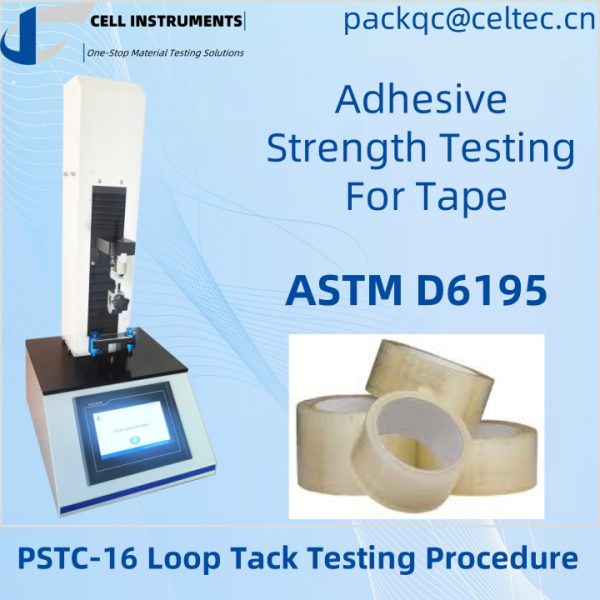How to Perform the PSTC-16 Loop Tack Testing Procedure for Adhesive Strength Testing for Tape
The PSTC-16 loop tack testing procedure is essential for measuring the tackiness of pressure-sensitive adhesives (PSAs). From packaging to medical applications, this test ensures that adhesive products meet necessary performance standards. Adhering to ASTM D6195 guidelines, it provides a repeatable and accurate method for evaluating the initial tack of adhesive tapes, which is critical for determining product quality.
Importance of Tack Testing in Adhesive Strength
Tack testing plays a crucial role in industries where adhesive performance is non-negotiable. Packaging materials, medical devices, and electronics rely heavily on high-quality adhesives to ensure integrity and functionality. The PSTC-16 loop tack test is specifically designed to measure the force required to detach a looped adhesive tape from a substrate. This gives manufacturers a clear understanding of the adhesive’s initial strength and its ability to stick during real-world applications.
Applications of PSTC-16 Testing:
- Packaging: Ensures that tapes maintain strong adhesion during storage and shipping.
- Medical: Ensures surgical tapes, wound dressings, and medical patches stay in place securely.
- Pharmaceuticals: Verifies the reliability of drug delivery patches.
- Electronics: Ensures adhesive components hold together in small devices, maintaining durability and performance.
Step-by-Step PSTC-16 Loop Tack Testing Procedure
Sample Preparation
Before starting the test, it’s important to prepare the adhesive samples. Cut a strip of adhesive tape to a uniform size, typically 25mm x 125mm, as specified in ASTM D6195. Make sure the sample is free from contaminants like dust or oil, which could affect the test outcome.
Loop Formation
Once the sample is prepared, create a loop with the adhesive side facing outwards. This loop will be used to evaluate how well the adhesive sticks to the substrate.
Test Execution
The adhesive loop is placed onto a test substrate under controlled speed and pressure conditions. The PSTC-16 loop tack tester applies a specific force to bring the loop into contact with the substrate. The key measurement is the force required to detach the loop from the substrate.
The loop tack tester from Cell Instruments provides precise control over the speed (1-500 mm/min) and pressure applied during this process, ensuring consistent results.
Measurement of Tack Strength
As the loop is removed from the substrate, the tester records the force required to detach the adhesive. This is the “tack” value, a critical indicator of the adhesive’s performance.
By using this method, manufacturers can verify if an adhesive meets the required tack strength for its intended use. This helps prevent product failures that could occur if an adhesive does not provide sufficient initial stickiness.
Importance of ASTM D6195 in PSTC-16 Testing
Adhering to ASTM D6195 ensures that results from the PSTC-16 test are reliable and consistent across different batches and production lines. ASTM D6195 outlines the specific steps needed to accurately assess the tackiness of adhesives. It offers clear guidelines for sample preparation, testing conditions, and result interpretation, making it the standard of choice for adhesive strength testing for tape.
Benefits of ASTM D6195 Compliance:
- Reliability: Provides consistent results, reducing variations across different test runs.
- Credibility: Increases trust in the product’s performance, especially for critical applications like medical and pharmaceutical uses.
- Efficiency: Simplifies quality control by offering a standardized, repeatable process.
Why Choose Cell Instruments’ PSTC-16 Loop Tack Tester?
When conducting PSTC-16 loop tack tests, using a high-quality testing instrument is essential. Cell Instruments’ PSTC-16 Loop Tack Tester stands out due to its accuracy, versatility, and ease of use.
Key Features:
- High Precision: Equipped with accurate sensors to detect even small variations in adhesive strength.
- User-Friendly Interface: Simplifies the setup and execution of the test process, reducing human error.
- Versatile Applications: Can be used across a range of industries, including packaging, medical, and electronics.
- Customization: Allows for tailored testing conditions, meeting specific industry needs.
Common Challenges in Loop Tack Testing
Despite the simplicity of the test procedure, there are common issues that can affect results. For instance, variations in sample preparation, environmental factors, and incorrect test settings can all influence the tack measurement. To avoid these pitfalls, it is important to follow ASTM D6195 guidelines and use precision instruments like the Cell Instruments PSTC-16 Loop Tack Tester.
FAQs
1. What is the PSTC-16 loop tack testing procedure?
The PSTC-16 loop tack test evaluates the initial tackiness of pressure-sensitive adhesives by measuring the force required to detach a loop of adhesive tape from a substrate.
2. How does PSTC-16 testing differ from other adhesive tests?
PSTC-16 focuses specifically on tack, which is the adhesive’s ability to stick to a surface immediately after application. Other tests may measure peel strength or shear resistance.
3. Why is ASTM D6195 important for adhesive testing?
ASTM D6195 provides standardized steps for loop tack testing, ensuring accurate, reliable, and repeatable results.
4. Can the Cell Instruments PSTC-16 tester be used for multiple adhesive types?
Yes, the Cell Instruments PSTC-16 tester is versatile and can be used to test a wide range of pressure-sensitive adhesives across industries.
5. How often should adhesive samples be tested using the PSTC-16 method?
Adhesive samples should be tested regularly during production, especially when making changes to formulations or applying new batches to ensure consistent quality.

